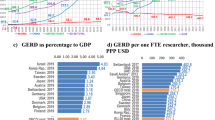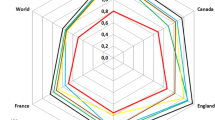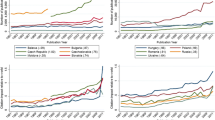Abstract
Three features of the output of scientific papers from Russia which are covered by SCI are reported for the period 1980 to 2000. Changes are related to the major politico-economic developments in the USSR and Russia, and contrasted with similar data from France, Canada and Italy. The problems of isolating Russian papers in the output of the USSR and of estimating the proportion of Russian papers without stated addresses are treated. The Russian annual output grew from 1980 to 1990, but fell by 20-24% after the dissolution of the USSR in late 1991; from 1994 there has been an inconsistent partial recovery, and by 2000 the annual output had approximately regained its 1980 value. The reduced output in the 1990s derives mainly from low government funding for science. The proportion of Russian papers produced in collaboration with other nations has grown from six percent in the early 1980s to 31% in 2000, while the principal regions of collaboration shifted rapidly after 1990 from other republics in the USSR and East Europe to Western Europe and North America. These changes were initiated by glasnost and the end of the Cold War, and more recently have been driven in part by a need for foreign support. Russia's annual output in the physical sciences in the 1980s was approximately twice, and from 1995 to 2000, approximately four times, that in the life sciences. This continuing dominance, which contrasts with the comparison countries, derives from the high priority given by the central governments to defense spending and related prestige projects.
Similar content being viewed by others
References
Aldhous, P. (1994). Biology: Elite groups struggle on with a little help from West. Science, 264(5163): 1264-1267.
Allakhverdov, A. (1994). Battle expands over shrinking budget. Science, 263(5144): 166. (News & Comment).
Allakhverdov, A. (1996). Russian scientists gain legal rights. Science, 273(5274): 424. (News & Comment).
Allakhverdov, A., Pokrovsky, V. (1997). Russia: Science agency hit with a 55% cut. Science, 276(5319): 1639. (News & Comment).
Anonymous. (1996). Down the test tubes. Economist, 340(7983): S10 (Book Review of The Economic Laws of Scientific Research, by T. Kealey, 1996).
Balzas, K., Faulkner, W., Schimank, U. (Eds), (1995). The research system in post-communist central and Eastern Europe. Social Studies of Science, 25(4) November (whole issue).
Berdashkevich, A. P. (2000). Science in Russia: Current state and prospects. Russian Education and Society, 42(12): 6-17.
Braun, T., GlÄnzel, W. (1996). International collaboration: Will it be keeping alive East European research? Scientometrics, 36(2): 247-254.
Boesman, W. C. (1998). Research and Development in Russia: An Important Factor for the Future. Congressional Research Service (CRS) Report for Congress 98-739. National Council for Science and the Environment, Washington, DC. 16 pp.
11_2001-1.html [accessed 25 June 2003].
Clery, D. (1994). Physics: A once-favoured discipline has the furthest to fall. Science, 264(5163): 1268-1270.
David, P. A. (1997). From market magic to calypso science policy. Research Policy, 26(2): 229-255. (Book Review of The Economic Laws of Scientific Research, by T. Kealey, 1996.)
Dezhina, I., Graham, L. (1999). Science and higher education in Russia. Science, 286(5443): 1303-1304.
Dialog (2003a). Dialog Home Page. Available: http://www.dialog.com [accessed 25 June 2003].
commands-5.shtml [accessed 25 June 2003].
Dickman, S. (1992). Cut off from the mainstream, Ukrainian science drifts. Science, 258(5079): 24-26. (News & Comment).
Dickson, D. (1989). Gorbachev lifts funds for civil R&D. New Scientist, 124(1685): 23.
Dyker, D. A., Radosevic, S. (Eds). (1999). Innovation and Structural Change in Post-socialist Countries: A Quantitative Approach. NATO ASI Series, 4. Science and Technology Policy, Vol. 20. Dordrecht: Kluwer Academic Publishers.
European Commission (2002). R&D and Innovation Statistics in Candidate Countries and the Russian Federation. Luxembourg: Office for Official Publications of the European Communities. 147 pp.
Fagerberg, J. (1987). A technology gap approach to why growth rates differ. Research Policy, 16(2-;4): 87-101.
Fortescue, S. (1992). The Russian Academy of Sciences and the Soviet Academy of Sciences: Continuity or disjunction? Minerva. 30(4): 459-478.
Garfield, E. (1990a). The Russians are coming! Part 1. The red-hot 100 Soviet scientists, 1973-;1988. In: Essays of an information scientist: Journalology, KeyWords Plus, and other Essays, 13: 202-215. Also available from: Current Contents, 24: 5-;18.
Garfield, E. (1990b). The Russians are coming! Part 2. The top 50 Soviet papers most cited in the 1973-;1988 Science Citation Index and a look at 1988 research fronts. In: Essays of an information scientist: Journalology, KeyWords Plus, and other Essays, 13: 216-226.
GlÄnzel, W., Schubert, A., Czerwon, H. J. (1999). A bibliometric analysis of international scientific cooperation of the European Union (1985-;1995). Scientometrics, 45(2): 185-202.
Gokhberg, L. (1999a). Russia: A Science and Technology Profile. British Council/Department of Trade and Industry. 134 pp.
Gokhberg, L. (1999b). Transformation of R&D in the post-socialist countries: Patterns and trends. In: D. A. Dyker, S. Radosevic (Eds). Innovation and Structural Change in Post-socialist Countries: A Quantitative Approach. NATO ASI Series, 4. Science and Technology Policy, Vol. 20. Dordrecht: Kluwer Academic Publishers. pp. 153-172.
Goldberg, A. I., Oigenblick, L., Rubin, A. H. E. (1997). Scientific articles and national medical cultures: A comparison of Russian and American medical journals. Scientometrics, 39(1): 57-75.
Goodman, B. (1993). Noted researchers laud donation to Russian science. The Scientist, 7(1): 3.
Gorelik, G. (1994). A blossoming under totalitarianism. Science, 264(5163): 1347-1349 (Book review of The Making of a Soviet Scientist, by R. Z. Sagdeev, 1994).
Gorodnikova, N. (1999). Transformation of R&D in Russia: The role of government priorities. In: D. A. Dyker, S. Radosevic (Eds). Innovation and Structural Change in Post-socialist Countries: A Quantitative Approach. NATO ASI Series, 4. Science and Technology Policy, Vol. 20. Dordrecht: Kluwer Academic Publishers. pp. 203-228.
Graham, L. R. (1998). What Have we Learned about Science and Technology from the Russian Experience? Stanford University Press: Stanford, California.
Hall, N. (1994). Ground-based astronomy: New borders divide up a once-strong basic discipline. Science, 264(5163): 1274-1275.
Hammond Incorporated (1979). Medallion World Atlas. Maplewood, New Jersey.
Havemann, F. (2001). Collaboration behaviour of Berlin life science researchers in the last two decades of the twentieth century as reflected in the Science Citation Index. Scientometrics, 52(3): 435-443.
Hicks, D. M., Isard, P. A., Martin, B. R. (1996). A morphology of Japanese and European corporate research networks. Research Policy. 25(3): 359-378.
ISI (Institute of Scientific Information). (1992). ISI Online Databases on Dialog. SciSearch®, Social SciSearch®, Arts & Humanities Search® & Current Contents Search® User Guide. Philadelphia: ISI.
Josephson, P. R. (1994). Russian scientific institutions: Internationalisation, democracy and dispersion. Minerva, 32(1): 1-6.
Kaiser, J. (1996). Russian research on the ropes. Science, 274(5294): 1827. (Science Scope).
Kaiser, J. (1997). Russian grants to remain duty free. Science, 276(5315): 1019. (Science Scope).
Katz, J. S. (1994). Geographical proximity and scientific collaboration. Scientometrics, 31(1): 31-43.
Kealey, T. (1996). The Economic Laws of Scientific Research. Basingstoke (UK): Macmillan; New York: St. Martin's Press.
Kealey, T. (1998). Why science is endogenous: A debate with Paul David (and Ben Martin, Paul Romer, Chris Freeman, Luc Soete and Keith Pavitt). Research Policy, 26(7-;8): 897-923.
Kealey, T., Rudenski, A. (1998). Endogenous growth theory for natural scientists. Nature Medicine, 4(9): 995-999.
Kerr, R. A. (1994). Earth science: Contacts with the West bring cultural revolution. Science, 264(5163): 1277-1279.
Lattimore, R., Revesz, J. (1996). Australian Science: Performance from Published Papers. Canberra: Bureau of Industry Economics. Report 96/3.
Luukkonen, T., Persson, O., Sivertsen, G. (1992). Understanding patterns of international scientific collaboration. Science, Technology and Human Values, 17(1): 101-126.
MacWilliams, B. (2001). Russia: Confidence despite adversity. In: Nature Year Book of Science and Technology. D. Butler (Ed.), New York: Palgrave/London: Nature Publishing Company, pp. 1354-1358.
Markusova, V. A., Griffith, B. C. (1991). Highly cited Soviet journals in the physical and life sciences: A study of the function of journals. Scientometrics, 21(1): 99-113.
Markusova, V. A., Arapov, M., Aversa, E. (1999). Collaboration between American and Russian scientists. In: Proceedings of the 7th International Conference on Scientometrics & Informetrics, Colima, Mexico. Universidad de Colima, Colima, July 5-;8, 1999, pp. 323-330.
Markusova, V. A., Minin, V. A., Libkind, A. N., Arapov, M. V., Jansz, C. N., Tijssen, R. (2001). Russian science in transition: The effects of new granting systems on research activity and output. In: Proceedings of the 8th International Conference on Scientometrics & Informetrics, University of New South Wales, Sydney, Australia, July 16-;20, 2001. Vol. 1, pp. 427-438.
Meske, W. (1999). Transformation of R&D in the post-socialist countries: Asset of liability? In: D. A. Dyker, S. Radosevic (Eds). Innovation and Structural Change in Post-Socialist Countries: A Quantitative Approach. NATO ASI Series, 4. Science and Technology Policy, Vol. 20. Dordrecht: Kluwer Academic Publishers. pp. 137-152.
Miller, E. (Ed.). (1999). SBS World Guide. 7th edition. South Yarra, Victoria: Hardie Grant Books. Russian Federation, pp. 602-615.
Mirskaya, E. Z. (1995). Russian academic science today: Its societal standing and the situation within the scientific community. Social Studies of Science, 25(4): 705-725.
Miquel, J. F., Okubo, Y. (1994). Structure of international collaboration in science — Part II: Comparison of profiles in countries using a link indicator. Scientometrics, 29(2): 271-297.
Narin, F. (1991). Globalization of research, scholarly information and patents — 10 year trends. Serials Librarian, 21(2/3): 33-44.
Nelson, R. R. (1997). A science funding contrarian. Issues in Science and Technology, 14(1): 90-92. (Book Review of The Economic Laws of Scientific Research, by T. Kealey, 1996).
Nelson, R. R. (1997). The problem of market bias in modern capitalist economies. Industrial and Corporate Change, 11(2): 207-244.
Nolting, L. E., Feshbach, M. (1980). R&D employment in the USSR. Science, 207(4430): 493-503.
Norman, C., Koshland, D. E. Jr. (1994). Science in Russia. Science, 264(5163): 1235. Editorial for Special Section Science in Europe '94: Russia, pp. 1259-;1282.
Pavitt, K. (1998). The social shaping of the national science base. Research Policy, 27(8): 793-805.
Peteri, G. (1995). On the legacy of state socialism in academia. Minerva, 33(4): 305-324.
Possehl, S. R. (1997). Keeping life sciences alive in Russia. Aerospace America, 35(3): 42-47.
Price, D. J. De Solla (1969). Measuring the size of science. Proceedings of the Israel Academy of Sciences and Humanities, 6: 10-11.
Russian science: Rockets into ploughshares. R. Sagdeev speaks to the Economist. (1990). Economist, 314(7647): 92. (Science and Technology).
Russian science seen from the West (1994). Science, 264(5163): 1260-1261.
19_2001-1.html [accessed 25 June 2003].
Salter, A. J., Martin, B. R. (2001). The economic benefits of publicly funded basic research: a critical review. Research Policy, 30(3): 509-532.
Schiermeier, Q. (2000). Russia's prize fighter. Nature, 408(6811): 398-399. (News feature).
Schubert, A., GlÄnzel, W., Braun, T. (1989). Scientometric data files. A comprehensive set of indicators on 2649 journals and 96 countries. Scientometrics, 16(1-;6): 3-478.
Schubert, A., Braun, T. (1990). International collaboration in the sciences, 1981-;1985. Scientometrics, 19(1-;2): 3-10. (World Flash on Basic Research).
SCI (Science Citation Index ®). (2001). ISI (Institute of Scientific Information) Thomson Scientific. SciSearch® via Dialog.
SCI (Science Citation Index ®) Guide and List of Source Publications. (1980-;1995). Philadelphia: ISI (Institute of Scientific Information).
SCI (Science Citation Index ®) 2000 Guide & List of Source Publications. Philadelphia: ISI & Thomson Scientific. 2001.
Science & Engineering Indicators. (2000). Arlington, VA: National Science Foundation. Available: http://www.nsf.gov/sbe/srs/seind00 [accessed 25 June 2003].
25_2002-2.html [accessed 25 June 2003].
25_2002-2.html [accessed 25 June 2003].
17_2002-1.html [accessed 25 June 2003].
Science in Russia: The diamonds in the rubble. (1997). Economist, 345(8042): 23-28.
Sher, G. S. (2000). Why should we care about Russian science? Science, 289(5478): 389.
Shmakin, B. (1995). War on anti-science. Nature, 374(6522): 491.
Shughart, W. F. II. (1997). Managerial and Decision Economics. 18(5): 414-416. (Book Review of: The Economic Laws of Scientific Research, by T. Kealey, 1996).
Sokolov, A. (1999). Statistics on information technology in Russia. In: D. A. Dyker, S. Radosevic (Eds). Innovation and Structural Change in Post-Socialist Countries: A Quantitative Approach. NATO ASI Series, 4. Science and Technology Policy, vol.20. Dordrecht: Kluwer Academic Publishers. pp. 419-428.
Soros, G. (2000). Who lost Russia? New York Review of Books, 47(6): 10-16.
Spurgeon, D. (2001). Optimism sweeps Canadian science. In: Nature Year Book of Science and Technology. D. Butler (Ed.), New York: Palgrave/London: Nature Publishing Company. pp. 556-560.
Stefaniak, B. (1998). International cooperation of Polish researchers with partners from abroad: A scientometric study. Scientometrics, 41(1-;2): 155-167.
Stone, R. (1998). A new initiative for Russian science. Science, 280(5368): 1336-1337. (News & Comment).
Stoneman, P. (1997). Economic Journal, 107(442): 844-845. (Book Review of The Economic Laws of Scientific Research, by T. Kealey, 1996).
Ulrich's International Periodicals Directory 1984. (1984). Twenty-third edition. R. R. Bowker Company. 2 vols.
Ulrich's International Periodicals Directory 1987-;88. (1987). Twenty-sixth edition. R. R. Bowker Company. 2 vols.
Ulrich's International Periodicals Directory 1992-;93. (1992). 31st edition. R. R. Bowker Company. 3 vols.
Ulrich's Irregular Serials and Annuals 1987-;88. (1987). Thirteenth edition. R. R. Bowker Company.
UNESCO Institute of Statistics. (2001) The state of science and technology in the world, 1996-;1997. Montreal, Quebec. 57 pp.
Ushkalov, I. G., Malakha, I. A. (2000). The ‘brain drain’ as a global phenomenon and its characteristics in Russia. Russian Education and Society, 42(12): 18-34.
Van Raan, A. F. J. (1999). Advanced bibliometric methods in the analysis of research performance and scientific developments: A contribution to science policy in transition countries. In: D. A. Dyker, S. Radosevic (Eds). Innovation and Structural Change in Post-socialist Countries: A Quantitative Approach. NATO ASI Series, 4. Science and Technology Policy, Vol. 20. Dordrecht: Kluwer Academic Publishers. pp. 89-105.
1357.0-WB.
Webb, T. D. (1994). Societies aid in large-scale effort to support Russian science. The Scientist, 8(2): 3.
Wilkie, T. (1996). British Medical Journal, 313(7058): 697. (Book Review of The Economic Laws of Scientific Research, by T. Kealey, 1996).
Wilson, C. S., Osareh F. (2003). Science and research in Iran: A scientometric study. Interdisciplinary Science Reviews, 28(1): 26-37.
Wines, M. (2001). At last, signs of economic revival in Russia. New York: The New York Times on the web. November 18, 2001.
World Factbook 2002. Available: http://www.cia.gov/cia/publications/factbook/geos/rs.html [accessed 25 June 2003].
Author information
Authors and Affiliations
Rights and permissions
About this article
Cite this article
Wilson, C.S., Markusova, V.A. Changes in the scientific output of Russia from 1980 to 2000, as reflected in the Science Citation Index, in relation to national politico-economic changes. Scientometrics 59, 345–389 (2004). https://doi.org/10.1023/B:SCIE.0000018539.93567.d8
Issue Date:
DOI: https://doi.org/10.1023/B:SCIE.0000018539.93567.d8




